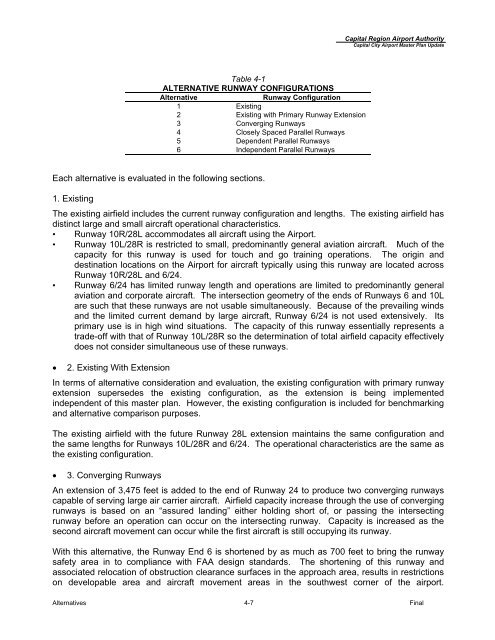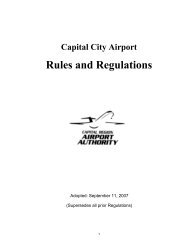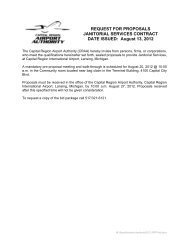Master Plan Update (pdf) - Lansing/Capital City Airport
Master Plan Update (pdf) - Lansing/Capital City Airport
Master Plan Update (pdf) - Lansing/Capital City Airport
You also want an ePaper? Increase the reach of your titles
YUMPU automatically turns print PDFs into web optimized ePapers that Google loves.
Table 4-1<br />
ALTERNATIVE RUNWAY CONFIGURATIONS<br />
Alternative Runway Configuration<br />
1 Existing<br />
2 Existing with Primary Runway Extension<br />
3 Converging Runways<br />
4 Closely Spaced Parallel Runways<br />
5 Dependent Parallel Runways<br />
6 Independent Parallel Runways<br />
Each alternative is evaluated in the following sections.<br />
<strong>Capital</strong> Region <strong>Airport</strong> Authority<br />
<strong>Capital</strong> <strong>City</strong> <strong>Airport</strong> <strong>Master</strong> <strong>Plan</strong> <strong>Update</strong><br />
1. Existing<br />
The existing airfield includes the current runway configuration and lengths. The existing airfield has<br />
distinct large and small aircraft operational characteristics.<br />
• Runway 10R/28L accommodates all aircraft using the <strong>Airport</strong>.<br />
• Runway 10L/28R is restricted to small, predominantly general aviation aircraft. Much of the<br />
capacity for this runway is used for touch and go training operations. The origin and<br />
destination locations on the <strong>Airport</strong> for aircraft typically using this runway are located across<br />
Runway 10R/28L and 6/24.<br />
• Runway 6/24 has limited runway length and operations are limited to predominantly general<br />
aviation and corporate aircraft. The intersection geometry of the ends of Runways 6 and 10L<br />
are such that these runways are not usable simultaneously. Because of the prevailing winds<br />
and the limited current demand by large aircraft, Runway 6/24 is not used extensively. Its<br />
primary use is in high wind situations. The capacity of this runway essentially represents a<br />
trade-off with that of Runway 10L/28R so the determination of total airfield capacity effectively<br />
does not consider simultaneous use of these runways.<br />
• 2. Existing With Extension<br />
In terms of alternative consideration and evaluation, the existing configuration with primary runway<br />
extension supersedes the existing configuration, as the extension is being implemented<br />
independent of this master plan. However, the existing configuration is included for benchmarking<br />
and alternative comparison purposes.<br />
The existing airfield with the future Runway 28L extension maintains the same configuration and<br />
the same lengths for Runways 10L/28R and 6/24. The operational characteristics are the same as<br />
the existing configuration.<br />
• 3. Converging Runways<br />
An extension of 3,475 feet is added to the end of Runway 24 to produce two converging runways<br />
capable of serving large air carrier aircraft. Airfield capacity increase through the use of converging<br />
runways is based on an “assured landing” either holding short of, or passing the intersecting<br />
runway before an operation can occur on the intersecting runway. Capacity is increased as the<br />
second aircraft movement can occur while the first aircraft is still occupying its runway.<br />
With this alternative, the Runway End 6 is shortened by as much as 700 feet to bring the runway<br />
safety area in to compliance with FAA design standards. The shortening of this runway and<br />
associated relocation of obstruction clearance surfaces in the approach area, results in restrictions<br />
on developable area and aircraft movement areas in the southwest corner of the airport.<br />
Alternatives 4-7 Final




